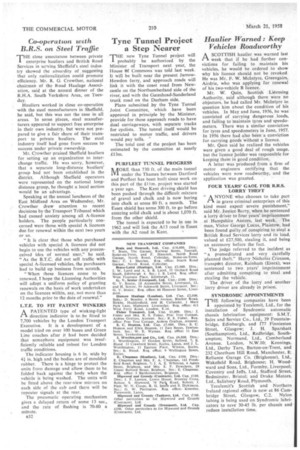Co-operatton wah B.R.S. on Steel Traffic
Page 36

If you've noticed an error in this article please click here to report it so we can fix it.
THE close association between private enterprise hauliers and British Road Services in serving Sheffield's steel industry showed the absurdity of suggesting that only nationalization could promote efficiency. Mr. R. G. Crowther, national chairman of the Road Haulage Association, said at the annual dinner of the R.H.A. South Yorkshire Area, on Tuesday.
Hauliers worked in close co-operation with the steel manufacturers in Sheffield, he said, but this was not the case in all areas. In some places, steel manufacturers appeared to support free enterprise in their own industry, but were not prepared to give a fair share of their transport to private hauliers. The steel industry itself had gone from success to success under private ownership.
Mr. Crowther praised Sheffield hauliers for setting up an organization to interchange traffic. He was sorry, however, that a separate long-distance hauliers' group had not been established in the district. Although Sheffield operators were represented on the national longdistance group, he thought a local section would be an advantage. , Speaking at the annual luncheon of the East Midland Area on Wednesday, Mr. Crowther drew attention to recent decisions by the Transport Tribunal which had caused anxiety among all A-licence holders. The people particularly concerned were those with special A licences due for renewal within the next two years or so.
"It is clear that those who purchased vehicles with special A licences did not begin to use the vehicles with any preconceived idea of normal user," he said. "As the B.T.C. did not sell traffic with special A-licensed vehicles, the purchasers had to build up business from scratch.
"When these licences come to be renewed, I hope the Licensing Authorities will adopt a uniform policy of granting renewals on the basis of work 'undertaken on the licences within, say, not more than 12 months prior to the date of renewal."
L.T.E. TO FIT PATENT WENKERS
A PATENTED type of winking-light 1"-I direction indicator is to be fitted to 7,700 vehicles by the London Transport Executive. It is a development of a model tried on over 100 buses and Green Line coaches after it had been decided that semaphore equipment was insufficiently reliable and robust for London traffic conditions.
The indicator housing is 6 in. wide by 41 in. high and the bodies are of moulded rubber. There is a hinge to protect the units from damage and allow, them to be folded back against the body when the vehicle is being washed. The units will be fitted above the rear-view mirrors on each side of the cab and there will be repeater signals at the rear.
The pneumatic operating mechanism gives a delayed return of some 13 sec., and the rate of flashing is 70-80 a minute.
B32








































































































